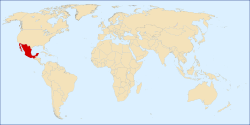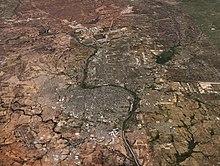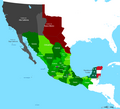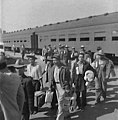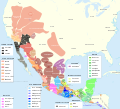Portal:Mexico
|
The Temple of Warriors at Chichen Itza, Mexico
¡Bienvenido! Welcome to the Mexico portal
Mexico, officially the United Mexican States, is a country in the southern portion of North America. It covers 1,972,550 km2 (761,610 sq mi), making it the world's 13th-largest country by area; with a population of almost 130 million, it is the 10th-most-populous country and the most populous Spanish-speaking country. Mexico is organized as a federal constitutional republic comprising 31 states and Mexico City, its capital. It shares land borders with the United States to the north, with Guatemala and Belize to the southeast; as well as maritime borders with the Pacific Ocean to the west, the Caribbean Sea to the southeast, and the Gulf of Mexico to the east.
This is a Featured article, which represents some of the best content on English Wikipedia.
The Convention of 1832 was the first political gathering of colonists in Mexican Texas. Delegates sought reforms from the Mexican government and hoped to quell the widespread belief that settlers in Texas wished to secede from Mexico. The convention was the first in a series of unsuccessful attempts at political negotiation that eventually led to the Texas Revolution. Under the 1824 Constitution of Mexico, Texas was denied independent statehood and merged into the new state Coahuila y Tejas. After growing suspicion that the United States government would attempt to seize Texas by force, in 1830 Mexican President Anastasio Bustamante enacted the Law of April 6, 1830 which restricted immigration and called for customs duty enforcement. Tensions erupted in June 1832, when Texas residents systematically expelled all Mexican troops from eastern Texas. (Full article...)Selected article -
Laredo–Nuevo Laredo (UN/LOCODE: USLRD & MXNLD) is one of six transborder agglomerations along the U.S.-Mexican border. The city of Laredo is situated in the U.S. state of Texas on the northern bank of the Rio Grande and Nuevo Laredo is located in the Mexican State of Tamaulipas in the southern bank of the river. This area is also known as the Two Laredos or the Laredo Borderplex. The area is made up of one county in the U.S (Webb County in Texas) and three municipalities in Mexico (Nuevo Laredo Municipality in Tamaulipas, Hidalgo Municipality in Coahuila, and Anáhuac Municipality in Nuevo León). Two urban areas (the Laredo Metropolitan Statistical Area and the Zona Metropolitana Nuevo Laredo [Nuevo Laredo Metropolitan Zone]), three cities, and 12 towns make the Laredo–Nuevo Laredo Metropolitan area. The two sides of the Borderplex are connected by four International Bridges and an International Railway Bridge. The Laredo–Nuevo Laredo Metropolitan area has a total of 636,516 inhabitants according to the INEGI Census of 2010 and the United States Census estimate of 2010. According to World Gazetteer this urban agglomeration ranked 157th largest in North and South America in 2010 with an estimated population of 675,481. This area ranks 66th in the United States and 23rd in Mexico. (Full article...)
Selected pictureThis is a Good article, an article that meets a core set of high editorial standards.
Miguel Ángel Chávez Velasco (born August 18, 1988), better known by his ring name Ángel de Oro (Spanish for "Angel of Gold" or "Golden Angel"), is a Mexican professional wrestler who works for the Mexican wrestling promotion Consejo Mundial de Lucha Libre (CMLL). He is currently a double champion in CMLL, as he is the Mexican National Light Heavyweight Champion and the World Tag Team Champion, both in his first reign. In 2018, he was defeated in a Luchas de Apuestas (mascara contra mascara; "mask vs. mask") match by El Cuatrero, and was forced to unmask and be identified. He is a second-generation luchador, the son of Apolo Chávez and the brother of the luchador Niebla Roja, who also works for CMLL. From 2008 to 2011, Ángel de Oro was part of a group called Los Ángeles Celestiales ("The Celestial Angels") alongside his brother (then billed as Ángel de Plata) and Ángel Azteca Jr., but after his brother changed his ring persona, that group has been phased out. After many years of portraying a tecnico ("Good guy") wrestling character, Ángel de Oro and his brother turned rudo and aligned themselves with El Terrible, eventually forming Los Nuevos Ingobernables. (Full article...)Selected biography -Miguel de la Madrid Hurtado (Spanish pronunciation: [miˈɣel de la maˈðɾið uɾˈtaðo]; 12 December 1934 – 1 April 2012) was a Mexican politician affiliated with the Institutional Revolutionary Party (PRI) who served as the 59th president of Mexico from 1982 to 1988. Inheriting a severe economic and financial crisis from his predecessor José López Portillo as a result of the international drop in oil prices and a crippling external debt on which Mexico had defaulted months before he took office, De la Madrid introduced sweeping neoliberal policies to overcome the crisis, beginning an era of market-oriented presidents in Mexico, along with austerity measures involving deep cuts in public spending. In spite of these reforms, De la Madrid's administration continued to be plagued by negative economic growth and inflation for the rest of his term, while the social effects of the austerity measures were particularly harsh on the lower and middle classes, with real wages falling to half of what they were in 1978 and with a sharp rise in unemployment and in the informal economy by the end of his term. (Full article...)
In the news
Selected fare or cuisine - Mexican wine and wine making began with the arrival of the Spanish in the 16th century, when they brought vines from Europe to modern day Mexico, the oldest wine-growing region in the Americas. Although there were indigenous grapes before the Spanish conquest, the Spaniards found that Spanish grapevines also did very well in the colony of New Spain (Mexico) and by the 17th century wine exports from Spain to the New World fell. In 1699, Charles II of Spain prohibited wine making in Mexico, with the exception of wine for Church purposes. From then until Mexico’s Independence, wine was produced in Mexico only on a small scale. After Independence, wine making for personal purposes was no longer prohibited and production rose, especially in the late 19th and early 20th centuries. Many other European immigrant groups helped with the comeback of wine in Mexico. However, the Mexican Revolution set back wine production, especially in the north of the country. Wine production in Mexico has been rising in both quantity and quality since the 1980s, although competition from foreign wines and 40% tax on the product makes competing difficult within Mexico. Mexico is not traditionally a wine-drinking country, but rather prefers beer, tequila and mezcal. Interest in Mexican wine, especially in the major cities and tourists areas (along with the introduction into the US on a small scale), has grown along with Mexican wines’ reputation throughout the world. Many Mexican companies have received numerous awards. Various wine producers from Mexico have won international awards for their products. In 2020, the wine Don Leo Gran Reserva Cabernet Sauvignon won gold in the International Cabernet competition (CIDC) and the trophy for the world's best Cabernet. The wine is produced in Parras, Coahuila in the Northwestern region of Mexico. (Full article...)
General imagesThe following are images from various Mexico-related articles on Wikipedia.
CategoriesTopicsRelated portalsWikiProjectYou are invited to participate in WikiProject Mexico, a WikiProject dedicated to developing and improving articles about Mexico. Associated WikimediaMore portals | ||||||||||




